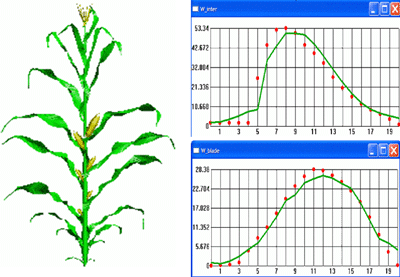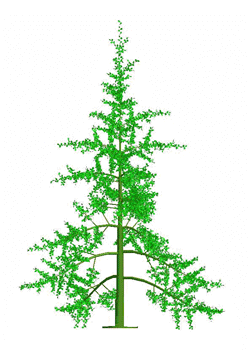
This issue in pdf Subscription Archive: Next issue: July 2005 |
|
|||||||
GreenLab: A Dynamical Model of Plant Growth for Environmental Applicationsby Paul-Henry Cournède and Philippe de Reffye Some of the most critical issues for sustainable development and the protection of the environment concern the rationalization of agriculture and forest exploitation. For this purpose, a research project at INRIA, DigiPlant, aims at developing both mathematical models of plant growth and related computing tools. Over the years, an important Sino-European collaboration has emerged, involving research institutes and universities, mathematicians and biologists. The cultivated areas of Europe, including agricultural land and exploitation forests, have a strong impact on global environmental conditions. Erosion, resource impoverishment due to over-exploitation, and pollution by fertilizers or pesticides are crucial problems that agronomy and forestry hope to solve through harmonious cultivation modes and exploitation strategies. For this purpose, they must take into account production needs on one hand and the environment on the other; that is to say, both quantitative and qualitative criteria. In this context, mathematical models of plant growth describing interactions between the architecture of the plant and its physiological functioning have a key role to play. They allow the exchanges (of water, carbon, minerals etc) between plants and their natural environment to be quantified.
GreenLab is just such a functional-structural model, and is the result of a long dialogue between botanists, physiologists and mathematicians. Derived from the AMAP model developed in the 1990s at CIRAD, GreenLab's new formulation was introduced at LIAMA (Beijing) in 2000. Today, the model is studied and improved upon through the DigiPlant project, which is run by a joint team of researchers from INRIA, CIRAD and Ecole Centrale Paris, and hosted by INRIA. Some very close partnerships exist with LIAMA, China Agriculture University, Wageningen University, Orsay University and INRA. A number of choices have been made in order to simplify biological knowledge and write the dynamical equations of growth. Organogenetic growth cycles are defined, and an automaton describing the evolution of the buds determines the plant architecture. The botanical concept of physiological age, defining a typology of the axes, allows a powerful factorization of the plant structure. Fresh biomass production is computed from transpiration and is then distributed among expanding organs (including buds) according to their demands (sinks). The available biomass determines the rules of the organogenetic automaton and the organ sizes, and plant architecture has a strong influence on photosynthesis. Thus, there is a very strong coupling between the growth equations. Stresses are also taken into account, especially for environmental resources. In particular, we have studied the competition between plants for light and water in plantations or crop fields. Plant density is also an important control parameter of the model.
The introduced mathematical formalism had a significant impact on the model analysis. First, the simulation software is strictly derived from the mathematical formalism. Thanks to the structural factorization, the computation time grows linearly with the chronological age of the plant (in comparison with a bud-by-bud simulation whose computing time grows exponentially with the plant's chronological age). Moreover, the mathematical study of the system allowed theoretical results on plant viability and yield prediction to be obtained. The best prospects, however, rely on our ability to clearly formularize optimal control problems and to fit the theoretical models to real plants. These two points are the keys to applications in agronomy and forestry. The hidden parameters of the model are very few (for example, twelve for an annual plant like maize). Agronomic data on maize, sunflowers, tomato, rice and wheat have been fitted with very good accuracy, and fittings on different plants of the same type have shown that the parameters are very stable. Some more complex plants like coffee, cotton and young beech trees are currently being studied.
The results of this research seem to show that in the near future, new tools of prediction, optimization and control could be effectively used in agriculture and forest exploitation on a large scale, and would drastically improve the management of the environment. Links: Please contact: Philippe de Reffye, INRIA, AMAP - CIRAD |
|||||||



